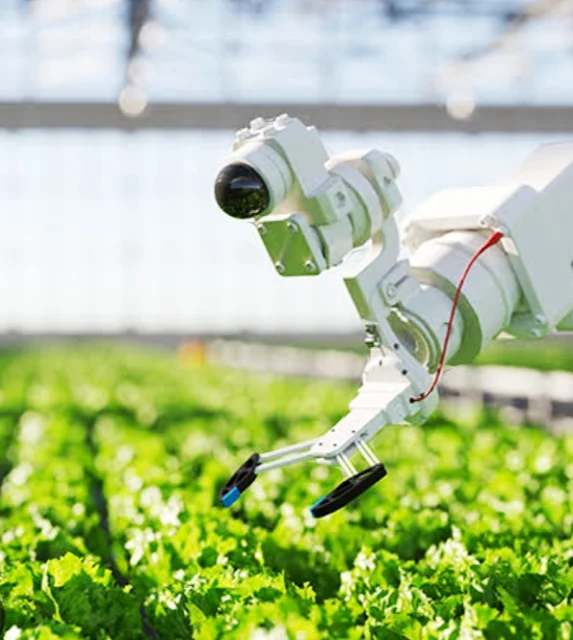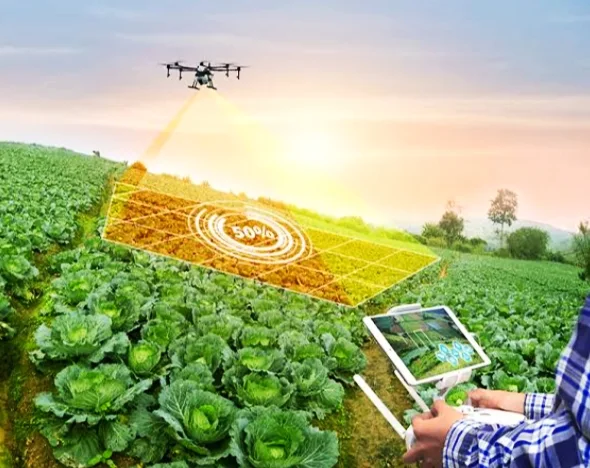Cultivating Innovation: The Rise of the Agritech Industry in India
India, a nation with a rich agricultural heritage, is witnessing a revolution of sorts. This transformation is being driven by agritech, a dynamic industry that leverages technology to empower farmers and enhance agricultural productivity.
A Booming Landscape: India is fertile ground for agritech. With over 3,000 startups, of which more than 1,300 utilize cutting-edge technologies like artificial intelligence and the Internet of Things, the industry is brimming with innovation. These startups offer a variety of solutions, from precision farming techniques that optimize resource use to online marketplaces that connect farmers directly to consumers. This not only improves efficiency but also empowers farmers, fostering a more transparent and profitable agricultural ecosystem.
Untapped Potential: Experts estimate the Indian agritech market to reach a staggering $24 billion by 2025. This immense potential stems from the vastness of the Indian agricultural sector itself. Despite being a major agricultural producer, India grapples with issues like fragmented land holdings, limited access to markets, and post-harvest losses. Agritech solutions address these challenges head-on, offering farmers better access to information, financial services, and high-quality inputs.
Challenges and the Road Ahead: Despite its promise, the agritech industry faces hurdles. Limited digital literacy among farmers and challenges in infrastructural development can hinder widespread adoption of these technologies. Bridging the digital divide and fostering collaboration between the government, private sector, and farmers is crucial for ensuring inclusive growth.
Cultivating Innovation: The Rise of the Agritech Industry in India
India, a nation with a rich agricultural heritage, is witnessing a revolution of sorts. This transformation is being driven by agritech, a dynamic industry that leverages technology to empower farmers and enhance agricultural productivity.
Challenges and the Road Ahead: Despite its promise, the agritech industry faces hurdles. Limited digital literacy among farmers and challenges in infrastructural development can hinder widespread adoption of these technologies. Bridging the digital divide and fostering collaboration between the government, private sector, and farmers is crucial for ensuring inclusive growth.
The Future is Green: The rise of agritech in India presents a compelling opportunity to transform the nation's agricultural landscape. By harnessing innovation, agritech can empower farmers, improve yields, and ensure food security for a growing population. As the industry matures, it has the potential to not only revolutionize Indian agriculture but also serve as a model for sustainable agricultural practices across the globe.
Tables on Agritech Industry in India
Investment in Agritech Industry
| Statistic | Description | Value |
|---|---|---|
| Total Private Equity Investment (2017-2020) | Cumulative investment in agritech startups | INR 66 billion |
| Growth Rate of Investment (2017-2020) | Year-on-Year increase in investment | Over 50% |
| Projected Market Potential | Estimated size of the agritech market by 2025 | US$24 billion |
| Largest Market Segment | Market segment with the highest potential | Supply chain technology and output markets (US$12.1 billion) |
Note:
- INR stands for Indian Rupee
- USD stands for US Dollar
Agritech Sub-sectors in India
| Sub-sector | Description | Example Technologies |
|---|---|---|
| Precision Agriculture | Techniques that utilize data to optimize resource use | Soil sensors, drone imagery, satellite data analysis |
| Farm Management | Software solutions for farm operations management | Cloud-based farm management platforms, financial planning tools |
| Supply Chain & Marketplaces | Platforms connecting farmers with buyers and streamlining logistics | Online marketplaces for farm produce, cold chain management solutions |
| Agri-financing | Fintech solutions for financial inclusion and loan access | Digital lending platforms, crop insurance solutions |
This table provides a more granular view of the various sub-sectors within the agritech industry in India, along with some examples of the technologies being used in each.
Key Player Company in India's Agritech Sector
India's agricultural sector is undergoing a digital revolution, with a new wave of agritech companies offering innovative solutions across the value chain.
Here's a look at some key player company in India Agritech making a significant impact, along with their table products:
| Company | Product | Focus Area |
|---|---|---|
| DeHaat | Farmer-to-business (B2B) platform | Connects farmers directly to institutional buyers, offering farm inputs, market access, and financial services. |
| Ninjacart | Supply chain management platform | Streamlines post-harvest logistics for fruits and vegetables, reducing wastage and ensuring better prices for farmers. |
| Bijak | AI-powered farm advisory platform | Provides personalized data-driven insights on weather, crop health, and market trends to improve farm yields and income. |
| Waycool | Cold chain logistics and agri-marketplace | Offers cold storage facilities and a digital platform connecting farmers with retailers and consumers. |
| Krishak | Precision farming solutions | Uses sensors, drones, and data analytics to optimize water usage, fertilizer application, and pest control. |
This table provides a snapshot, but the Indian agritech landscape is vast and ever-evolving. Here are some additional points to consider:
- Focus on specific crops: Many companies cater to specific crops like pulses, rice, or cotton, offering tailored solutions for their unique needs.
- E-commerce integration: Several agritech platforms integrate with e-commerce giants, allowing farmers to sell directly to consumers and access wider markets.
- Financial inclusion: Access to credit and insurance is a major challenge for Indian farmers. Agritech companies are developing innovative financial products to bridge this gap.
The rise of these agritech companies is transforming Indian agriculture by:
- Improving farm productivity and efficiency
- Empowering farmers with better market access and information
- Reducing post-harvest losses
- Promoting sustainable agricultural practices
By leveraging technology and innovation, these key players are paving the way for a more secure and prosperous future for Indian agriculture.
The Future is Green: The rise of agritech in India presents a compelling opportunity to transform the nation's agricultural landscape. By harnessing innovation, agritech can empower farmers, improve yields, and ensure food security for a growing population. As the industry matures, it has the potential to not only revolutionize Indian agriculture but also serve as a model for sustainable agricultural practices across the globe.
Frequently Asked Questions About India's Agritech Industry
1. What is the current state of Agritech in India?
India has a rapidly growing Agritech industry, driven by its large agricultural sector and increasing adoption of technology. Key factors contributing to its growth include:
- Government support: The Indian government has implemented policies and initiatives to promote Agritech development.
- Research institutions: A strong network of research institutions and universities is working on Agritech.
- Start-up ecosystem: A vibrant Agritech start-up ecosystem is emerging in India, with numerous successful companies.
2. What are some of the key trends in Indian Agritech?
- Mobile technology: Mobile phones are widely used in India, and Agritech companies are leveraging this to provide farmers with information and services.
- Precision agriculture: Technologies like drones, sensors, and data analytics are being used to optimize crop management and resource use.
- E-commerce: Online platforms are connecting farmers with buyers, both domestically and internationally.
- Artificial intelligence (AI): AI is being used for tasks such as image recognition, predictive analytics, and natural language processing.
3. What are some of the leading Agritech companies in India?
- DeHaat: A rural e-commerce platform that connects farmers with input suppliers and buyers.
- Ninjacart: A supply chain platform that connects farmers with supermarkets and retailers.
- Cropify: A company that provides drone-based agricultural services.
- FarmGuide: A mobile app that provides farmers with agricultural information and advice.
4. What challenges do Indian Agritech companies face?
- Infrastructure: Lack of reliable infrastructure, such as roads and electricity, can be a challenge for Agritech companies.
- Financial constraints: Access to financing can be difficult for Agritech start-ups.
- Market fragmentation: The Indian agricultural market is fragmented, making it challenging for companies to reach a large customer base.
5. What is the future outlook for Indian Agritech?
- Continued growth: The Indian Agritech sector is expected to continue growing, driven by factors such as increasing population and the need for more efficient and sustainable agriculture.
- Focus on smallholder farmers: There will likely be a continued focus on developing Agritech solutions that benefit smallholder farmers.
- Integration with other technologies: Agritech will likely be integrated with other technologies, such as the Internet of Things (IoT) and blockchain.


